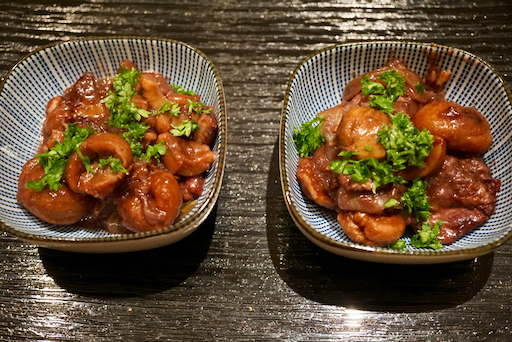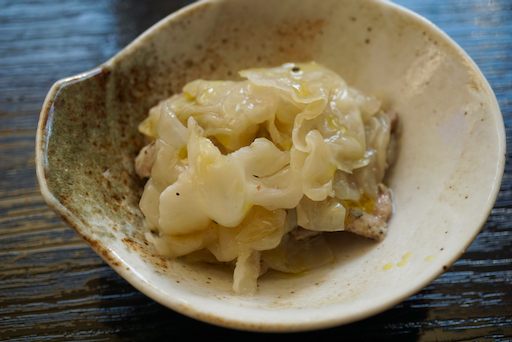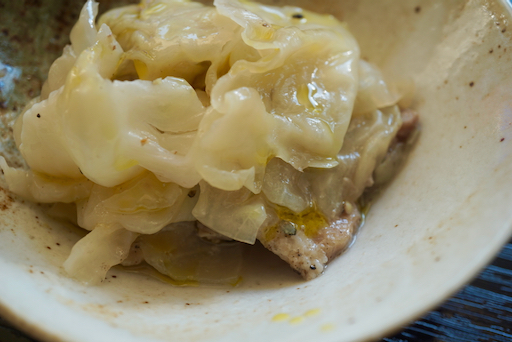Sunday, June 2, 2024
Steak and 2004 Insignia ステーキディナーと2004 Joseph Phelps Insignia
Friday, April 28, 2023
Lamb Tenderloin for Easter 子羊のテンダーローイン
I sort of did a reverse searing. After cooking it in the toaster oven, I seared it with sprigs of fresh rosemary which I kept in the frying pan during the searing and while I made a red wine sauce.
As sides, we served pencil asparagus and shiitake mushroom stir fry (left) and Israeli couscous salad with marinated artichoke hearts (right). To mop up the sauce, we also served a slice of (mini) baguette I baked.
I have never cook lamb tenderloins before. I decided to cook two of them in the toaster oven at 350F for 10 minutes and then reverse seared them in a pan with rosemary. It sort of worked but the lamb was a bit overcooked. The entire dinner was really good and for the occasion, we opened a bottle of 2014 Insignia from Joseph Phelps. Despite some age on the bottle, it was really fresh with a nice fruit flavor. It was a perfect wine for this dinner.
Ingredients (makes about 4 servings)
x2 Lamb tenderloins thawed, salted and kept in the refrigerator for 6 hours uncovered (to dry them a bit)
2 springs of fresh rosemary
2 tbs olive oil
Salt and pepper to taste
for the pan sauce
1/4 cup red wine (Not Insignia; a much more reasonably priced CA wine I already had open)
1 tsp balsamic vinegar
2 tbs of cold butter, cut into thin pats
Salt and pepper
Directions:
I seasoned the lamb with pepper (no salt; it was already salted). I roasted it at 350F in the toaster oven on convection mode for 10 minutes.
I then pan-seared it with olive oil and the rosemary for 1 minute on each side.
I set aside the lamb covered loosely with an aluminum foil, leaving the rosemary in the pan.
(I was aiming for an internal temperature of 130-135F for the lamb to be medium rare but in the end, the temperature went over)
I added the red wine and balsamic vinegar to the pan and reduced it to the point that it was just coating the bottom of the pan.
I added several pats of cold butter one by one until it reached a saucy consistency.
I seasoned with salt and pepper
I sliced the lamb tenderloin and spooned on the wine sauce then topped the dish with the rosemary sprig.
The couscous salad, asparagus with mushroom and baguette all worked well together with the lamb. Of course, the wine made this dinner a bit special.
Wednesday, May 25, 2022
Steak dinner with Insignia 2012 ステーキとインシグニア2012
We rarely eat steak. This time, on the strong recommendation from my wife’s sister, we got a “special”package from Omaha Steaks which included, among a lot of other things, filet mignon. (It was called “Butcher’s cut”. We are not sure where this cut ranks on their quality scale of steaks). In any case, an occasion called for a special dinner and wine. So we cooked the steak and opened 2012 Joseph Phelps Insignia. The package from Omaha Steaks also included scalloped potato (shown here lower right) which I served with the steak, caprese salad and sautéed green beans.
The wine was excellent. It was not too aged with nice dark fruit, vanilla and chocolate and well structured but mellowed tannin. In general we are not a great fans of old wines but this was just nicely aged for us to enjoy.
Sunday, May 8, 2022
$10 red wines 10ドルの赤ワイン
We have tried quite a few $10 a bottle red wines in the past (from California , Spain, Chile, Argentina, Italy and France) which got high marks (meaning 90 or near it) by wine experts. Every time we were disappointed (which may be at least partly due to what we look for in a red wine). My sweet spot for red wine or house red wine is between $20-30 a bottle, mostly from California and also Spain and Australia. Our current favorites in this category are “Pessimist” (Petit Sirah, Zinfandel and Syrah based blend) and “ Cabernet Sauvignon” (both from from DAOU vineyards in Paso Robles), “Black Stallion Cab” (from Napa) and “Juggernaut Hillside Cabernet Sauvignon” (From Clarksburg, CA).
*We were not sure why this wine is called “Pessimist” initially then we found the following statement on the back label: “a pessimist is never disappointed”, which has some philosophical resonance.
But, recently, we came across these two $10 red wines through Vivino which are quite good and very drinkable.
In the picture below, the left and center are "Athena Cabernet sauvignon 2019 and 2020" and the right is “Leyth California red” (blend of Petite Syrah and Merlot similar to Pessimist). Both are $10 a bottle and if you buy more than 6 bottles, the shipping is included. I am not sure of current availability, though.
Friday, January 21, 2022
Tasting of plum wine made in 1997 and 1998 梅酒飲み比べ.
In the past we used to regularly make plum wine 梅酒 with the plums we harvested from the Japanese plum tree we planted in our back yard. It has been some time however, since we made any plum wine There are several reasons for this: 1: Initially the plum tree was very productive and over the years we accumulated quite a stash of plum wine, 2: Then, about 10 years ago our plum tree, as well as most of the ornamental plum trees in the neighborhood got some kind of fungal disease. Many of the trees died of the disease, but we transplanted ours to a different location in the yard and severely trimmed back the diseased portion. We were not sure if it would survive and certainly during this period it did not produce any fruit. So we did not make any plum wine. Miraculously it not only survived but in the past few years, it started producing fruit again. It is a much smaller tree than it was at its peak and the plum yield is much less. We have been judiciously harvesting the plums to make a type umeboshi or slated plum.
In any case, I recently stumbled across two bottles of plum wine labeled as started in 1998 (bottled in 1999) and 1997 (bottled in 1998). Both bottles had some cloudiness or precipitate, probably something to do with plum pulp. Both are made of 40% proof Vodka so I was not worried that the “plum wine” may have gone bad. In any case, using a filter paper for filtering cooking oil, I filtered out the sediment and re-bottled the wine in smaller bottles (picture below). The 1997 vintage (one on the right) is much darker probably indicating more oxidation.
So, it was very natural to do vertical tasting.
Both are quite mellowed out and quite good. They almost tasted like aged port. Interestingly, both had their own distinctive flavor and character. The 1997 vintage had a slightly more complex taste. Besides tasting the plum wine straight, we also diluted it with carbonated water which served us as a substitute for Champagne to celebrate New Year’s eve. It did not taste like Champagne but looked exactly like it and provided a refreshing alternative libation.
Friday, October 29, 2021
Chicken stew with red wine and chestnuts 鳥もも肉と栗の赤ワイン蒸し煮
Ingredients:
2 chicken thighs, bone removed and cut into bite size
200 ml dry red wine (I used Tempranillo from Rivera del duero which I happened to have)
2 bay leaves
1 medium onion, cut into rings
1/3 celery stalk, sliced on bias
1 clove garlic
2 tbs vegetable oil (I used olive oil)
1 tbs butter (I used unsalted)
2 tbs AP flour
10-15 prepared chest nuts (I used commercial chestnuts from a jar)
2 tsp Worcester sauce
Fresh parsley, chopped, for garnish
Directions:
Marinate the chicken in the red wine and the bay leaves for one hour (room temperature) or overnight (in the refrigerator).
Remove the chicken, reserve the marinade and the bay leaves
Season the chicken with salt and pepper, dredge in the flour and set aside
Add the oil to the pan and sauté the garlic, celery, and onion. Remove when cooked and softened and set aside.
In the same pan, melt the butter and brown the chicken pieces.
Add back the vegetables and the marinade with the bay leaves, the Worcester sauce and cook for 15 minutes mixing occasionally.
Garnish with chopped parsley.
Friday, July 31, 2020
Red wine "Zuke" tuna and avocado 鮪の赤ワイン漬けとアボカド
Ingredients: (appetizers for two)
1/2 block of sashimi tuna (in our case, frozen yellowfin), thawed if frozen, cut into small cubes
1/2 ripe avocado
Marinade:
3 tbs red wine (I had an open California cab).
2 tbs soy sauce (I reduced the soy sauce from the original recipe)
1 tbs mirin
1/4 tsp dark sesame oil
In a Ziploc bag, add the marinade and tuna cubes. Remove the air as much as possible and let it marinate in the refrigerator for a few hours (in my case, it was close to10 hours).
Just before serving, take out the tuna cubes, blot off the excess marinade using a paper towel.
>Remove the stone and skin from the avocado, cut into bite-sized pieces, dress with either lemon juice or yuzu juice (to prevent discoloration, I used yuzu juice from the bottle).
Mix the tuna and avocado in a bowl ( I added a few more drops of Yuzu juice).
Serve on the perilla leaves and garnish with a chiffonade of perilla and some sesame seeds.
Tuesday, July 7, 2020
Pork belly and cabbage steamed in wine 豚バラとキャベツの塩蒸し
Ingredients
1/4 Cabbage, small head, leaves separate and washed and torn into bite sized pieces.
1lb slices of pork belly (They were a bit thicker than Japanese bura-bara. I pounded them thin, and cut into a bite sized pieces).
3 tbs white wine (We had a small amount of rose from Provence left over so I used that. It was more than 3 Tbs. more like 1/3 cup).
1/3 tsp salt
2 tsp oilve oil
slat and pepper for the meat.
Directions
Season the pork with salt and pepper.
In a pan, make alternating layers of cabbage and pork.
Add the wine, salt and olive oil, put it on medium flame with a lid.
Turned down the flame to low when it starts boiling.
Cook until the pork is cooked and cabbage is soft.
Serve hot, if needed season with additional salt and pepper (I sprinkled on our favorite Spanish olive oil)
This is a simple but good dish. Since the pork was well seasoned no additional seasoning was needed. It was good that I used up the cabbage I had, the left over wine and the last of pork belly slices.



















